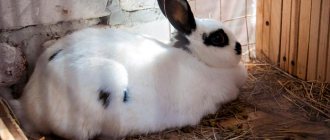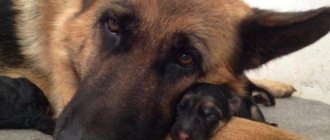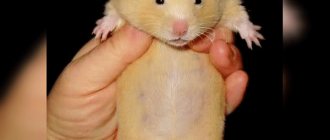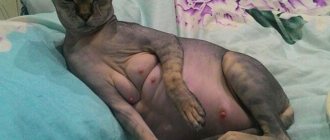Labrador pregnancy and childbirth are a joyful event for the whole family. It is important for the dog owner to know the first signs and how long the Labrador's pregnancy lasts in order to determine the due date. Often owners are interested in Labrador's pregnancy week by week or day by day. It is important to know what to feed your dog during pregnancy. You need to make sure that this is not a false pregnancy. The main goal of the owner is the birth of healthy puppies and maintaining the health of the mother. To avoid mistakes when breeding a Labrador, you need knowledge. Therefore, we will try to answer all these questions.
At what age can Labradors be bred?
In order for the offspring to be healthy, and the process of birth and mating not to be too difficult for dogs, you need to know at what age the appropriate period for their reproduction begins.
As a rule, males mature earlier than females. For them, the suitable age for mating is 18 months. The female becomes ready for the mating procedure no earlier than two years.
NOTE!
The difference in age is due to the fact that after mating the bitch begins the period of pregnancy and childbirth. The dog must be sexually mature and adult to produce healthy offspring.
Research and analysis
Most likely, you gave your pet an anthelmintic even before the planned mating, treated hidden infections if there were any, and also vaccinated the bitch on time. But there are also force majeure situations.
Many veterinarians do not advise vaccinating pregnant dogs at all, but if you live in a disadvantaged area (for example, a stray flock has settled nearby), it is better to try to vaccinate your animal. Manufacturers of complex vaccinations write in the annotations that their product can be used in the first trimester after conception. Doctors, as a rule, play it safe and give vaccines to pregnant bitches before 15 days.
The same can be said about antiparasitic drugs. But there is no consensus on the treatment of infections during pregnancy - specialists make decisions based on the experience and recommendations of colleagues and assessing possible risks.
Although Labradors are most likely to cope with pregnancy and childbirth themselves, have the phone number of a trusted veterinarian handy. At the very beginning, you need to make sure that fertilization has taken place and the pregnancy is proceeding normally. You can determine pregnancy in a dog in the laboratory by:
- taking a blood test to determine the concentration of the hormone relaxin (in a bitch preparing to give birth, it significantly exceeds the reference values for non-pregnant women);
- Ultrasound examination (ultrasound) - it can be carried out from 21 days after mating, optimally - on the 25th day;
- listening to the puppies' heartbeats with a stethoscope (after 25–30 days).
How to understand that a pet is ready for mating?
To correctly set a mating date, you need to know when your pet goes into heat. This phenomenon repeats itself cyclically once every 6-8 months, but it also happens once every 10 months - this is also the norm.
Some external signs will help to correctly determine whether a dog is ready to conceive offspring:
- The animal becomes more restless and listens less to you;
- On walks, he very carefully sniffs almost every object he encounters;
- Follows your commands reluctantly.
If you have a bitch, then she says about the period of estrus:
- Loop increase;
- The appearance of liquid bloody discharge in the pet;
- The dog becomes attractive to males and may even allow him to approach her.
But this is only a certain stage of the entire period. It lasts 7-10 days and during it conception is still impossible.
You must wait until the next stage, which is characterized by:
- Colorless discharge, the amount of which is noticeably reduced;
- When touched to the croup, the dog instinctively assumes a mating position;
- There is no doubt that the bitch will allow the male to approach her.
This stage lasts five days and mating must occur during this stage.
If you have a male dog, then you will also notice changes in his behavior. Carried away by the smell, he can become almost uncontrollable when walking, so he must always be on a leash.
Pregnancy and childbirth of a Labrador.
So your dog is mated. Pregnancy or whelping is the period from conception to childbirth. From the first mating this period is 63 days. It is normal for puppies to be born at 59 or 66 days. Dogs, like people, may vomit in the morning. This is usually observed at 3-4 weeks of pregnancy and is associated with hormonal changes and stretching of the uterus. At this time, it is recommended to feed the bitch several times a day in small portions, and you can also consult a veterinarian about medication to relax the tone of the uterus.
During the first half of pregnancy, you can feed the dog as usual, deworming if you did not do this before mating. It is necessary to increase the duration of walks in the fresh air, and from the second half of pregnancy switch to a diet for puppy dogs. Of course, you can feed your dog natural food, but this is not rational, it’s the same as using laundry soap if you have washing powder. A puppy dog needs about 1.5 kg of meat per day to cover energy costs and not touch the reserves of her own body; in addition, vitamins and mineral elements are needed in a certain proportion, as well as carbohydrates and fats. All this is contained in concentrated ready-made dry food. It is better to use professional food “Hill's”, “Eucanuba”, or “Diamond”, “Purina Pro Plan” and some others. These companies produce a large number of brands of food, including for pregnant bitches. The main rule for using dry food is that you must not deviate from the manufacturer’s feeding recommendations indicated on the packaging and in no case should you exceed the dosage. More than 10 years ago, I first started feeding dogs dry food and my own bitch successfully carried puppies, whelped, nursed a litter of 7 puppies (and fed milk for more than two months), the weight loss was extremely insignificant, she did not shed hair at all and shedding was almost complete unnoticed. Compared to the state with previous matings and natural feeding, I felt a significant difference.
External signs of pregnancy
Enlargement of the abdomen, as well as the weight of the dog, no more than 35-30 days left before birth Swelling of the vagina, the appearance of mucous transparent discharge no more than 20 days left before birth Swelling of the mammary glands, you can palpate the puppies through the abdominal wall no more than 15-10 days left before birth Through the wall of the abdomen, you can notice active movement of the fetus until birth, no more than 7-10 days left. A decrease in body temperature, the appearance of colostrum remains no more than 3-2 days before birth. A decrease in temperature by 1.5-2 degrees, a significant decrease in appetite or refusal to feed until no more than 1 day left of birth
A puppy bitch needs daily exercise in the form of non-tiring walks, and in the first half of pregnancy it can not be limited, but in the second half it is necessary to limit the bitch in sudden movements, jumping, and energetic movements.
A playpen with special restraints for the bitch so that she cannot crush the puppies and with a reflector for heating the babies.
The time of birth is approaching. The bitch should give birth at home, in a familiar environment. Sometimes an unfamiliar environment and strangers in the house lead to a delay and suspension of labor. I personally know one such Labrador bitch who does not give birth while someone is in the same room with her. The nest for puppies should be placed in a calm and quiet place where no one will disturb the bitch. The optimal size of the playpen for a female Labrador with puppies is 150 x 200 cm. The walls of the box are made so high that older puppies cannot climb out of it on their own. on one side you need to make a hole for the mother and a door that can be closed. You need to lay a sufficient layer of newspapers on the bottom of the arena and change them as they become dirty. An old blanket or piece of faux fur should be placed on top of the newspapers so that the puppies can rest their paws well. Before giving birth, the dog loses its appetite, becomes restless, begins to dig the litter, becomes agitated, and breathing quickens. A day before the birth itself, the rectal temperature drops by 1.5 - 2 degrees, but at the time of birth the temperature rises. The birth process can be divided into three stages - dilation of the cervix, birth of the puppies and birth of the placenta. During the first period, the bitch breathes very heavily, pushing begins - a chaotic contraction of the muscles of the uterus, while the puppy moves from the horns into the uterus. When contractions or contractions of the uterus occur, the puppy is pushed towards its cervix and it opens. At the same time, the abdominal muscles contract and the puppy moves into the vagina. This is where the second stage of labor begins. The amniotic sac appears from the loop, ruptures, the flowing amniotic fluid of light straw color irrigates the birth canal and the puppy is born. A good mother always strives to treat the puppy herself; she ruptures the amniotic sac with her teeth, bites off the umbilical cord and begins to thoroughly lick the puppy, massaging it with her tongue and stimulating breathing and blood circulation. From the outside it sometimes seems that she treats him rather rudely, but in fact she awakens in him the desire to live. If the mother does not respond to newborn puppies, then you yourself must take care of her offspring. To do this, you should always have on hand boiled scissors immersed in an antiseptic solution (furacillin solution is suitable for these purposes, 1 tablet dissolves in a glass of boiling water), a bottle of brilliant green and clean diapers. First of all, you need to break the bubble around the puppy’s muzzle and free the mouth and airways, then cut the umbilical cord, after squeezing the blood out of it, about 4 cm from the puppy. After this, dip the umbilical cord in a bottle of brilliant green, then you can rub the puppy with dry diapers, imitating the actions of the mother. If you leave the umbilical cord too short, the bitch may begin to chew the cord on her own when her instinct finally kicks in, and the puppy may be injured. The placenta is delivered a few minutes after the puppy is born, but sometimes it arrives with the puppy or a few hours after birth. It is necessary to keep strict records of the birth rate of placentas, because the placenta remaining in the uterus can cause acute metritis, which, in turn, can lead to the death of the bitch. You can create a special table where you will enter the order of birth of the puppies, their weight at birth, the presence or absence of an afterbirth (placenta) and marks (if the puppies are the same color). To do this, you can use colored woolen threads, which are worn in the form of collars and will need to be replaced as the puppies grow with larger ones.
The bitch will try to eat the placenta during childbirth, do not prevent this, as they contain traces of oxytocin - a hormone that stimulates labor and the onset of milk production, and thus the appearance of maternal instinct. During birth, various complications can arise, such as the puppy being in the wrong position, or suddenly the bitch stops pushing at the moment when the puppy is only halfway through the cervix. In this case, you should try to grab the puppy with your fingers and pull it towards the exit. It is best to pull the puppy by the skin to avoid damaging his joints. But if that doesn’t work (he goes with his head), then it’s best to grab his head behind the ears with your index and middle fingers. If he walks with his hind legs, then you should not pull on them; it is best to try to hook him around the waist using the same technique as in the first case. The puppy should not be allowed to stand in the aisle, as in this case the umbilical cord will be pinched and the puppy will begin to reflexively breathe, which can lead to death. If you can’t catch the puppy, you can “push” it back and wait for stronger contractions, during which it can be born alive. Often the puppy is pulled with rocking (rotation) - first in one direction, then in the other direction. In other cases, you need to contact a specialist.
If the puppy is born and shows no signs of life or is not breathing, take the puppy in your hands, fixing its head, and shake it in an arc with its head down, stopping abruptly above the floor. This helps remove water from the respiratory tract. Sometimes owners of bitches resort to stimulation of labor. What do you need to know about this? Oxytocin is contraindicated in a number of cases, for example, when contractions have just begun and the cervix is not fully dilated; when the puppy is too big and cannot be born; during strong contractions. You must remember that inappropriate use of oxytocin and its dosage can lead to uterine rupture.
How to determine the end of labor? As soon as the last puppy was born, my bitch immediately starts eating! To do this, I keep a bowl ready and towards the expected end of labor I begin to offer her food. While she is giving birth, she does not touch food, but with the last puppy she begins to show interest in food. In addition, if the bitch did not expel all the placenta or did not give birth to puppies that died in utero, then the discharge from the loop acquires a black-green color and, over time, a putrid odor. This can lead to acute metritis (inflammation of the uterus) and only a specialist can help the dog. Therefore, after childbirth, it is necessary to carefully monitor the discharge from the loop and the condition of not only the offspring, but also the mother. If the birth was successful, all the placenta came out - the cervix closes and the next day the bitch does not have any discharge. And after a day or two, mucous discharge of a dark red color appears and lasts two to three weeks. By the end of this period, the discharge lightens and acquires a light pink tint.
Another problem that sometimes arises with a whelping or (and more often) lactating bitch is eclampsia or postpartum tetany. It is expressed by convulsions without loss of consciousness in animals. Tetany occurs when calcium is overused during pregnancy or lactation. Therefore, dairy dogs are mainly affected, and sometimes eclampsia occurs during the peak of milk production, which corresponds to 21-24 days from the start of feeding. Calcium leaves the bitch's body along with milk, but phosphorus remains. This leads to a violation of the very important relationship between these elements. These disorders are accompanied by seizures. Early signs include restlessness, restlessness, and whining. The bitch lies in a tense position, her eyes are slightly bulging, her breathing is rapid and heavy. Sometimes the temperature rises. In this case, it is necessary to urgently prescribe a course of calcium injections. For this purpose, a 10% solution of calcium gluconate is suitable, which is administered intramuscularly in a dose of 3-5 ml. In addition, you can give an injection of oxytocin and seduxen. To calm your breathing, place a plastic bag over your head, but not tightly! In this condition, diet does not play a role.
At first, the mother herself will care for the newborn puppies. If the bitch’s maternal instincts are developed normally, then the nest will always be clean, the feces will be removed by herself, the puppies will be licked clean, fed and warm. Your task is to keep the bitch clean, make sure that she regularly shifts from one side to the other in order to avoid stagnation of milk in the mammary glands, which can lead to mastitis and very unpleasant consequences.
The start of the first complementary feeding (if the bitch has a sufficient amount of milk) occurs at 3-4 weeks from the date of birth. It is better to start complementary feeding with food intended for puppies from 3-4 weeks of age. The brand of food does not matter; usually such food is produced by professional companies and the food is called “Starter”, for example “Royal Canine Starter Pro”, “Happy Dog Starter”, etc. If the bitch does not have enough milk in the first days of the puppies’ life, you can purchase ready-made concentrated bitch milk. There is no need to experiment with cow's milk, yolk and honey, as was advised in the old days. At that time, there were no professional feeds in our country, and cow’s milk in its composition is very far from dog’s milk, fatter and less protein. For intensive growth, puppies require a lot of protein, not fat or carbohydrates, so you should not give them milk porridge. The enzyme system of the gastrointestinal tract of puppies is very delicate and the slightest failure can lead to serious problems. Even the most beautiful dog can be ruined by improper feeding in the first months of life. We must remember and be aware of this. The breeder must budget his funds and be prepared for the fact that he will have to buy food, the cost of which in the end sometimes exceeds the cost of several puppies. Saving on feeding puppies and feeding them porridge or mashed potatoes out of poverty is a crime! In the end, such puppies will never make worthwhile dogs. They are expected to have lifelong diseases of the gastrointestinal tract, a decrease in the body’s resistance (resistance) and a tendency to various diseases. And again, all claims will be addressed only to the breeder. Once again, listen to the advice: before breeding a bitch, weigh it a hundred times, count it, and become imbued with responsibility for the future offspring.
Author of the article: Tatiana Dimitriu, Stenveyz nursery
On what day of heat should you breed?
It turns out that great responsibility falls on the female, because she will have to bear and give birth to offspring. Conception should not occur on any day of estrus; there are special favorable days for this, when the chance of the bitch becoming pregnant is much higher.
To figure out what day dogs should mate, you need to know about the three periods of estrus in a female:
- Proestrus - during this stage, the eggs mature inside the ovaries. The dog becomes more aggressive and disobedient, and leaves behind a lot of marks on walks.
- Estrus , or sexual heat. This stage occurs on the 10th day after the first. It lasts 4-6 days and is characterized by the release of the egg from the ovary and its movement along the fallopian tube. It is at this stage that mating should occur, that is, it is the 11-14th day of estrus.
- Metestrus is the stage when the dog’s body returns to its normal state.
IMPORTANT!
To know when estrus begins, the owner must monitor the condition and behavior of the dog more than one estrus. Immediately before mating with a dog, you need to be examined by a veterinarian.
How many puppies can a dog give birth to?
Every owner who has bred his bitch involuntarily thinks about the size of the expected litter.
Many things depend on how many fruits were conceived, for example, the bitch’s feeding diet and her physical activity. So. How many puppies will be born? The fertility of dogs depends on many factors. For example, in order to have a high probability of getting a multiple litter, you need to guess the day of mating. Knit exactly when the number of mature eggs is maximum. If you mate earlier, not all eggs are mature and capable of fertilization, but here you can correct the situation by control mating every other day. And if you are late, then some of the eggs have already lost their ability to fertilize. There's nothing we can do about it.
The health of the bitch, her feeding diet, living conditions, and hormonal levels also affect the quality and quantity of eggs. The optimal condition for mating is factory. If the bitch is exhausted or overfed, this will certainly affect the number of puppies - the litter will be infertile, or the bitch will miss out altogether.
The father, that is, the male, also has a direct influence on the number of puppies in the litter. Sperm quality depends on age, frequency of mating and diet. The sperm of a male dog that mates more than twice a month, or a male dog older than ten years, will have a lower sperm content. In addition, sperm are weak and not everyone manages to reach the goal.
How to choose a pair?
When choosing a pair, especially if one of the dogs is mating for the first time, you need to be extremely responsible. It will be better if one of the Labradors - a female or a male - already knows what to do. Therefore, for the first mating of a female, select an experienced partner, and vice versa.
Of course, all dogs have highly developed instincts, and experience may not be useful. There are many cases where young Labradors did everything right the first time, but it’s better to be safe.
Preparing the dog
In order for mating and further pregnancy to go without problems, you need to follow some rules:
- Carry out a comprehensive bacteriological analysis. A month and a half before estrus and potential mating, contact a veterinary clinic to have your dog examined. Tests will reveal whether there are any viruses in the dog’s body that can negatively affect future offspring.
- Treat your dog's skin for parasites. This must be done in a month. You can use different shampoos.
- The dog must undergo deworming.
- Vaccination course. This course must be completed after seven, when the deworming course is completed.
For a male dog, these recommendations will be enough - males, for the most part, do not need overly thorough preparations, because they only participate in conception.
It would also be a good idea for the female to undergo the following tests:
- Analysis for brucellosis - this bacterium can cause miscarriage or stillbirth of puppies;
- Ultrasound of the uterus and ovaries - you need to make sure that there are no tumor formations or cysts;
- A blood test and a vaginal smear - this way you will know whether there is any inflammatory process going on in your pet’s body.;
- A blood test for progestron is a motherhood hormone. Its level in the body indicates whether the dog is ready to become a mother in the future or not;
- X-ray. Only needed for females who have already had a caesarean section to exclude the presence of adhesions.
False pregnancy of a Labrador: signs, danger
False pregnancy in a Labrador is a condition that causes signs of expecting puppies. It manifests itself as behavioral or physiological symptoms.
Behavioral signs include:
- Restless behavior of a Labrador.
- The dog diligently arranges a place for future babies. Then he begins to take care of some objects. For example, these could be toys. They replace puppies for a dog.
- Begins to protect his place and imaginary children.
- If there are other people's puppies nearby, the dog actively takes care of them.
Physiological signs include:
- Changes in body structure.
- The belly is growing in size.
- The nipples swell and enlarge. They may become inflamed, as will the surrounding skin.
- The body swells.
- Experienced females show signs of labor.
- Sometimes vomiting occurs.
- There is lethargy and drowsiness.
A false pregnancy in a Labrador can appear 6-10 weeks after mating. The reasons have not yet been reliably studied. It is believed that there is a hormonal imbalance. It is possible that embryos die at the initial stages of development. Or the egg was not fertilized.
To determine if a retriever has a false pregnancy , carefully observe:
- A truly pregnant bitch does not begin to take care of and protect her toys.
- During real pregnancy, the hair around the nipples thins. Because future puppies must find their way to their mother's milk by touch.
- Precursors to childbirth are temperature fluctuations during the day. This is not the case with a false pregnancy.
A Labrador's false pregnancy lasts from a week to a month. This condition should go away on its own.
But, if you see that it is bothering your dog, contact a veterinary clinic. To avoid complications, it is better to examine the dog. For example, infection of the uterus or mammary glands may occur. In addition, signs of a false pregnancy in a retriever must be differentiated from diseases of the pituitary gland or thyroid gland.
If a Labrador's false pregnancy recurs regularly, pyometra or mammary cancer may develop. The doctor should order an ultrasound and laboratory tests.
Basic Rules
Basic rules for knitting step by step:
- On the day of mating, dogs do not need to be overfed. Eating should take place 3-4 hours before a potential meeting.
- Since the male plays the dominant role in the mating process itself, it is better to meet on his territory.
- If the dog is very nervous in a new environment, then taking sedatives 1-1.5 before meeting the animals will help.
- Before intercourse, both dogs need to be walked and wait for bowel movements.
- Trim and sharpen the dog's nails so that he does not injure the bitch's back.
- If the mating is planned for a hot time, for example in the summer, then plan the meeting in the morning or evening hours, when the sun is not too hot.
- If a dog is mating for the first time, the release of hormones can provoke aggression. It is better not to be near them, or provide your pet with a muzzle and a leash with a collar.
- Make sure there is clean water in the area accessible to dogs.
- Do not interfere with animals sniffing and getting to know each other. There's no need to rush here.
- Do not rush to complete the act, wait until the dogs move away from each other.
Expert opinion
Kozhevin Semyon Kirillovich
Expert dog handler.
The most important thing here is not to interfere or show unnecessary concern. Before mating, you should already know everything or a lot about this process so that some things cannot scare or shock you. Believe me, dogs know better than you what to do. It’s enough just to observe, because excessive attention can confuse the dogs and interfere with the process.
Character and training of the Labrador breed
The Labrador is an incredibly smart and obedient dog. This breed has an active and cheerful disposition, for which it is very loved. You will not find a single case of a Labrador attacking a person.
- Active. A Labrador is considered a puppy until it reaches 3 years of age. But even after this time, the dog remains cheerful and playful. This should be taken into account during training. Conduct training in the form of a game. It is even more interesting to involve children in the learning process. Both the dog, the children, and the owner will receive immense pleasure from the process itself.
- Employee. This breed cannot be classified as a working breed. Labrador is too friendly to apprehend criminals or guard objects. However, representatives of this breed actively serve humans in other cases. They are used as guide dogs. There are cases when Labradors acted as rescuers. It is this peaceful and balanced breed, along with horses and dolphins, that is used to treat autistic children.
- Balanced. Despite the playful disposition and playful behavior, the Labrador is distinguished by its patience and balance. You will never meet a Labrador who barks without meaning to. He does not attack animals or people. This is an incredibly smart breed.
- Sensitive. Despite all its positive qualities, the Labrador, like any other animal, can commit mischief and misbehavior. However, do not rush to apply punishment. A stern tone is enough for your pet to understand that he behaved incorrectly. The Labrador is extremely sensitive to reprimand.
When training a Labrador, you should show maximum patience, because sometimes the dog may not immediately understand what they want from it, or the playful puppy cannot tune in to the required wave.
Go to class in a good mood. If you are not in the mood, then the activity will be useless. As a reward, use a special toy that is used only for training. If you prefer to reward with treats, then use a product that is not available to your Labrador in a normal diet. Choose small pieces so that your dog does not waste time chewing.
Labrador puppy
How can you tell if your dog is pregnant?
If a Labrador is pregnant, you will find out about it no earlier than 3-4 weeks after mating.
The main signs of pregnancy in a Labrador:
- Swelling of the nipples;
- Increasing the dog's waist;
- Sometimes toxicosis, which manifests itself in vomiting from eating familiar foods.
NOTE!
Before you find out that your dog will soon have offspring, do not rush to change his lifestyle. Let your pet eat and run as usual, and change the routine later.
History of the breed
Debates still rage about how Labrador got to the Canadian island of Newfoundland. What is known for certain is that it was there that they began to use unusual dogs that incredibly love water and enjoy splashing in it.
Mostly fishermen lived on the island. Every day they practiced their difficult craft, and unusual dogs called Newfoundland dogs helped them in this. There are two known breeds that lived on the island - large and small. Large dogs had long, thick hair, and the hair of small dogs had unusual water-repellent properties. It was this second variety that became the ancestor of Labradors. At that time, the breed was simply called St. John's dogs (from the capital of the province of Newfoundland). All day long the dogs helped catch fish, searched for nets, pulled out fallen prey and brought it to their owner. Later, Labradors began to be used as rescue dogs. So it was considered important to take at least one Labrador on a voyage. In the event of a shipwreck, the dog swam ashore, holding a rope in its teeth, along which fishermen climbed out of the sea.
In the 19th century, dogs began to be exported from the island to the United States and Europe. In European countries, breeding of the breed was difficult, since the exported dog had to undergo a six-month quarantine.
However, despite the difficulties, the Labrador took root in Europe, and later came to Russia. At the end of the 19th century, the first breed standard was adopted, exhibitions began to be held and clubs were created.
How is pregnancy progressing?
Labradors are pregnant for approximately 9 weeks (62-64 days).
| A week | Description |
| 1 Week | There are no visible changes. The dog behaves as it always does, but sometimes owners notice that the pet has become a little more nervous and restless. |
| 2 week | The dog develops clear mucous discharge from the loop: the egg is immersed in the wall of the uterus. |
| 3 week | Signs of toxicosis may appear. The dog feels sick and vomits. This is due to hormonal changes in the body. During this period, the puppy already looks like a small embryo. |
| 4 week | You can't feel the puppies through the stomach yet, but with the help of an ultrasound you can determine exactly how many of them are inside. |
| 5 week | The appearance of the Labrador changes - it increases in volume, the waist becomes wider. You should no longer physically overload your dog, and walks should not be long. |
| week 6 | The mammary glands enlarge and the nipples swell. The dog becomes more careful and does not risk making any sudden movements. If this does not happen, you will have to restrain your Labrador and monitor him yourself. |
| week 7 | The belly is already becoming noticeably larger. You can easily feel the puppies stomach. |
| 8 week | The puppies begin to move. Their movements are noticeable not only when palpating, but also when the dog is at rest. |
| Week 9 | Puppies stop moving a few days before giving birth. They may be born this week. By this time, the dog should have a birthing place, where it will spend the entire birth process. |
Childbirth can begin either earlier than expected or later. Therefore, you need to be on guard, starting from day 58, and monitor the dog every day.
If childbirth is too late or much earlier than necessary, this is considered a pathology. In this case, they must take place in the presence of a veterinarian.
Pregnancy of a Labrador: last days before giving birth
When there are 2-7 days left before birth, temperature surges appear. During these days, measure your dog's temperature 2 times a day to know when contractions are approaching.
- Before birth, body temperature drops to 37%.
- The stomach drops, which is clearly visible from the back.
- The dog begins to behave restlessly, sleep poorly, and whine.
- Begins to ask to go to the toilet frequently. Sometimes urinary incontinence occurs.
- The day before giving birth, the dog may refuse to eat.
- Some dogs require extra attention from their owner. Others, on the contrary, hide away.
If a bitch is giving birth for the first time, without the help of a specialist, it can end in the loss of the puppy, the entire litter, or herself. An older bitch can also have complications during childbirth. If there are signs of labor, the due date has approached, but there are no contractions, you need to urgently seek help.
Watch the video: Labrador Retriever pregnancy. Just 5 minutes.
Labrador pregnancy and childbirth are an important and responsible event for the whole family. It is best to make an appointment with your doctor in advance to deliver your dog. Since there is always a danger of incorrect position of the fetus or weakening of labor. An obstetrician will help keep mother and babies healthy.
How does childbirth take place and how to deliver it?
Usually childbirth in Labradors is easy, and the bitch copes with everything herself at home. Difficulties may arise during the first birth or when the female is already old.
In the first case, the dog will need your little help in helping the puppy to be born, and in the second, a caesarean section.
The intervals between the appearance of puppies should be no more than half an hour, and the process itself takes 5-6 hours.
IMPORTANT!
If you see that it is difficult for a dog to give birth, and everything around speaks about it - bloody discharge, the puppy cannot appear for a long time, then this is a reason to call a doctor at home.
Reviews from Labrador owners
My review is both positive and negative at the same time. We got our chocolate Labrador from a not very conscientious breeder. It turned out that he had a congenital urinary tract disease and the baby had to undergo several abdominal surgeries. from us, and we started looking on the forum for brothers and sisters of our baby from this litter. There was one unfortunate sister with hip dysplasia. We still communicate with her owner and are very worried about our pets.
Despite all the hardships of the disease, our chocolate monster has not lost its playfulness and activity. He loves to ride in the car, and sometimes presents “surprises” in the form of a chewed stool. Despite everything, we love him madly, just as he loves us.
Svetlana, Tomsk
We adopted Milo from a very famous nursery. The puppy cost us a pretty penny, but we didn’t regret the money, since we bought a healthy puppy of my favorite color. I approached the arrival of a puppy in the house with all responsibility - I took a vacation while he sat at home in quarantine for the first 3 weeks. What can I say, during the year that he lived with us, everything happened - torn wallpaper, and a chewed sofa. I didn’t always need to do it on the street. But my boyfriend and I didn’t have that much time to hang out with him all the time. It’s good that our apartment has an old renovation and the same furniture. I hope our Milo will grow up and not be so mischievous.
Svetlana, Voronezh
How many puppies can be born?
Each time the number of puppies is individual. Usually their number is 5-6, but this also depends on heredity and how carefully the preparation for mating was carried out.
Often, during her first birth, a young bitch can even give birth to 1-2 puppies.
There are cases when dogs that are too old to give birth give birth to 11-12 dogs. In this case, you cannot do without a cesarean section, and in general such births are very dangerous for the health of the Labrador.
Labrador breed standard: characteristics
The Labrador breed standard regulates controversial issues and accurately indicates the external and psychological characteristics of this breed.
The main breed feature of the Labrador is the tail. It should look very similar to an otter's tail.
- General form . A large dog with a wide skull and a strong body. Characterized by active behavior and balance.
- Behavior . Frisky, active, without any aggression. He is very obedient to his master and strives to please him in everything.
- Head . There are no cheeks, the transition from the forehead to the muzzle is clearly defined. The muzzle is powerful, but not sharp. Eye color can be dark brown or hazel. Drop ears are set far from the muzzle.
- Frame . Wide chest, straight back. The whole body is large and strong. The tail is thick at the base and tapers towards the end. It is covered with short, coarse hair.
- Paws . Smooth, strong, with developed pads.
- Wool . Dense wool with an interesting undercoat that has water-repellent properties. The color can be black, brown (from light to dark chocolate), fawn (from beige to red).
Adult dog size
The Labrador is a fairly large, but not huge dog. So the male has a height of 56-57 cm, and the female - 54-56 cm. As you can see, the range of acceptable sizes is small. The same cannot be said about the weight of a purebred dog. So a male can weigh from 30 to 36 kg, and a female - 27-32 kg. Labradors are prone to obesity, so it is necessary to take a competent approach to the preparation of their diet.
Lifespan
Like all large dog breeds, Labradors do not live very long. It is believed that this dog lives for a minimum of 10 years, and the maximum threshold is 13-14 years. Both the duration and quality of life directly depend on nutrition, lifestyle, active physical activity, timely observation by a veterinarian, and timely vaccination.
What to feed after childbirth?
Nutrition after birth during lactation is a very important aspect that affects the growth and health of the mother and growing puppies.
In terms of nutritional composition, the feed should consist of:
- Protein – 30-35%;
- Fats – 20-30%;
- Coarse cellulose – 1-2%;
- Calcium – 1.5-2%;
- Phosphorus – 0.9-1%;
- Vitamin A;
- Energy value – 4200-5000 kcal/kg.
If you are feeding your bitch food, then on the shelves of the pet store you can easily find specialized brands for nursing dogs. The main thing is to take only those that are super premium and holistic.
NOTE!
If the bitch eats natural food, then you will have to try to improve her diet. It should contain those products that can be easily absorbed by the dog’s body. There should not be anything salty, spicy, fatty or smoked - this will negatively affect the digestion of the female, milk, and also the puppies.











